Скачать материал

Скачать материал




- Сейчас обучается 398 человек из 63 регионов




Описание презентации по отдельным слайдам:
-
1 слайд
Aspects of Lexical Meaning
Lecture -
2 слайд
ASPECTS OF LEXICAL MEANING
THE DENOTATIONAL ASPECT
THE CONNOTATIONAL ASPECT
THE PRAGMATIC ASPECT
COMPONENTIAL ANALYSIS -
3 слайд
1. THE DENOTATIONAL ASPECT
The denotational aspect of lexical meaning is the part of lexical meaning which establishes correlation between the name and the object, phenomenon, process or characteristic feature of concrete reality (or thought), which is denoted by the given word.
e.g. booklet — ‘a small thin book that gives information about something’ -
4 слайд
Through the denotational aspect of meaning the bulk of information is conveyed in the process of communication.
The denotational aspect of lexical meaning:
expresses the notional content of a word.
is the component of the lexical meaning that makes communication possible. -
5 слайд
2. THE CONNOTATIONAL ASPECT
The connotational aspect of lexical meaning is the part of meaning which reflects the attitude of the speaker towards what he speaks about. Connotation conveys additional information in the process of communication.
-
6 слайд
Connotation includes:
The emotive charge is one of the objective semantic features proper to words as linguistic units and forms part of the connotational component of meaning, e.g. daddy as compared to father.
a hovel – ‘a small house or cottage’ – implies a miserable dwelling place, dirty, in bad repair and in general unpleasant to live in. -
-
8 слайд
Evaluation, which may be positive or negative, e.g.
clique (a small group of people who seem unfriendly to other people) as compared to group (a set of people);
celebrated (widely known for special achievement in science, art, sport, etc.) as compared to notorious (widely known for criminal act or bad traits of character). -
9 слайд
Imagery:
to wade – to walk with an effort (through mud, water or anything that makes progress difficult). The figurative use of the word gives rise to another meaning, which is based on the same image as the first – to wade through a book ; -
10 слайд
intensity/expressiveness, e.g. to adore – to worship – to love – to like;
connotation of cause, duration etc. -
-
-
-
14 слайд
Thus, a meaning can have two or more connotational components.
The given examples present only a few: emotive, evaluative connotations, and also connotations of duration and of cause. -
15 слайд
3. Examples of different types of Connotation
I. The connotation of degree or intensity
to surprise — to astonish — to amaze — to astound;
to satisfy — to please — to content — to gratify — to delight — to exalt;
to shout — to yell — to bellow — to roar; to like — to admire — to love — to adore — to worship -
16 слайд
II. Connotation of duration
to stare — to glare — to gaze — to glance — to peep — to peer;
to flash (brief) — to blaze (lasting);
to shudder (brief) — to shiver (lasting);
to say (brief) — to speak, to talk (lasting). -
17 слайд
III. Emotive connotations
to stare — to glare — to gaze;
alone — single — lonely — solitary;
to tremble — to shiver — to shudder — to shake;
to love — to admire — to adore — to worship;
angry — furious — enraged;
fear — terror — horror. -
18 слайд
IV. The evaluative connotation
well-known — famous — notorious — celebrated;
to produce — to create — to manufacture — to fabricate;
to sparkle — to glitter;
A.His (her) eyes sparkled with amusement, merriment, good humour, high spirits, happiness, etc. (positive emotions).
B.His (her) eyes glittered with anger, rage, hatred,
malice, etc. (negative emotions). -
19 слайд
V. Causative connotation
to sparkle — to glitter;to shiver — to shudder;
to blush — to redden.
-
20 слайд
VI. Connotation of Manner
to stroll — to stride — to trot — to pace — to swagger — to stagger — to stumble;
to peep — to peer;
to like — to admire — to love — to adore — to worship. -
21 слайд
VII. The connotation of attendant circumstances
One peeps at smb./smth. through a hole, crack or opening, from behind a screen, a half-closed door, a newspaper, a fan, a curtain, etc. It seems as if a whole set of scenery were built within the word’s meaning. It is not quite so, because «the set of scenery» is actually built in the context, but, as with all regular contexts, it is intimately reflected in the word’s semantic structure. -
22 слайд
One peers at smb./smth. in darkness, through the fog, through dimmed glasses or windows, from a great distance; a short-sighted person may also peer at things. So, in the semantic structure of to peer are encoded circumstances preventing one from seeing clearly.
-
23 слайд
VII. Connotation of attendant features
Pretty – handsome – beautiful;
special types of human beauty:
beautiful is mostly associated with classical features and a perfect figure;
handsome with a tall stature, a certain robustness and fine proportions,
pretty with small delicate features and a fresh complexion. -
24 слайд
IX. Stylistic connotations
(Meal). Snack, bite (coll.), snap (dial.), repast, refreshment, feast (formal).
These synonyms, besides stylistic connotations, have connotations of attendant features.
Snack, bite, snap all denote a frugal meal taken in a hurry; refreshment is also a light meal; feast is a rich or abundant meal.
(Girl). Girlie (coll.), lass, lassie (dial.), bird, birdie, jane, fluff, skirt (sl.), maiden (poet.), damsel (arch.). -
25 слайд
Anecdote
J a n e: Would you be insulted if that good-looking stranger offered you some champagne?
J o a n: Yes, but I’d probably swallow the insult. -
26 слайд
3. THE PRAGMATIC ASPECT
The pragmatic aspect is the part of lexical meaning that conveys information on the situation of communication. Like the connotational aspect, the pragmatic aspect falls into four closely linked together subsections. -
27 слайд
1. Information on the ‘time and space’ relationship of the participants
Some information which specifies different parameters of communication may be conveyed not only with the help of grammatical means (tense forms, personal pronouns, etc), but through the meaning of the word.
E.g. come and go can indicate the location of the speaker who is usually taken as the zero point in the description of the situation of communication -
28 слайд
The time element is fixed indirectly. Indirect reference to time implies that the frequency of occurrence of words may change with time and in extreme cases words may be out of use or become obsolete.
E.g.the word behold – ‘take notice, see (smth unusual)’ as well as the noun beholder – ‘spectator’ are out of use now but were widely used in the 17th century. -
29 слайд
2. Information on the participants and the given language community;
The language used may be indicative of the social status of a person, his education, profession, etc.
The pragmatic aspect of the word may convey information about the social system of the given language community, its ideology, religion, system of norms and customs.
a) They chucked a stone at the cops, and then did a bunk with the loot.
b) After casting a stone at the police, they absconded with the money. -
30 слайд
3. Information on the tenor of discourse
The tenors of discourse reflect how the addresser (the speaker or the writer) interacts with the addressee (the listener or reader).
Tenors are based on social or family roles of the participants of communication.
1. Don’t interrupt when your mother is speaking (family roles).
2. There is an awful man in the front row, who butts in whenever you pause (social roles). -
31 слайд
4. Information on the register of communication
The conditions of communication form another important group of factors. The register defines the general type of the situation of communication grading the situations in formality. Three main types of the situations of communication: formal, neutral and informal.
I’m sorry if upset you, dear. I certainly didn’t mean to (informal).
There are certain qualities in his works that I greatly admire (formal).
Who is the girl I saw you with yesterday? (neutral). -
32 слайд
LEXICAL MEANING
Denotational Connotational Pragmatic aspect aspect aspectEmotive charge
Evaluation
Imagery
Intensity
Connotation
Information on the
‘time and space’
Information on the participants and
the givenlanguage community
Information on the tenor of discourse
Information on the register of communication -
33 слайд
IV. Componential analysis = semantic decomposition
rests upon the thesis that the sense of every lexeme can be analyzed in terms of a set of more general sense components or semantic features, some or all of which will be common to several different lexemes in the vocabulary.
-
34 слайд
Componential analysis
attempts to treat components according to ‘binary’ opposition:
male/ female,
animate/ inanimate,
adult/ non-adult,
human/ non-human.
The sense of man might be held to combine the concepts (male, adult, human).
The sense of woman might be held to differ from man in that it combines (female (not male), adult, human). -
35 слайд
Componential analysis allows us to group entities into natural classes.
man and boy (human, male),
man and woman (human, adult).
There are certain verbs, such as marry, argue, that are found with subjects that are [+human]. Moreover, within the English pronoun system, he is used to refer to [human] entities that are [+male] while she is used for [human] entities that are [not male]. -
36 слайд
Componential analysis of the word ‘bachelor’
According to the dictionary it has 4 meanings:a man who has never married (холостяк);
a young knight (рыцарь);
someone with a first degree (бакалавр);
a young male unmated fur seal (морской котик) during the mating season. -
37 слайд
Bachelor
Noun
(Human) (Animal)
(Male) [who has the first of (Male)
lowest academic degree][who has [young knight serving [young fur seal when
never married] under the standard of without a mate during
another knight] the breeding time][who has never [young knight serving [young fur seal when
married] under the standard of without a mate during
another knight] the breeding time] -
38 слайд
The old bachelor finally died.
‘Bachelor’ is not the fur seal (they are young).
(young) => is a marker not the distinguisher.
Theoretically there is no limit to the number of markers.
Markers refer to the features which the lexeme has in common with other lexical items,
a distinguisher differentiates it from all other items.
Distinguishers can be regarded as providing a denotational distinction, while semantic markers represent conceptual components of the meaning of lexical items. -
39 слайд
Componential analysis
gives its most important results in the study of verb meaning, it is an attractive way of handling semantic relations. It is currently combined with other linguistic procedures used for the investigation of meaning. -
40 слайд
References:
Зыкова И.В. Практический курс английской лексикологии. М.: Академия, 2006. – С.- 18-21.
Гинзбург Р.З. Лексикология английского языка. М.: Высшая школа, 1979. – С.- 20-22.
Бабич Н.Г. Лексикология английского языка. Екатеринбург-Москва. 2006. – С.- 61- 62.
Антрушина Г.Б., Афанасьева О.В., Морозова Н.Н. Лексикология английского языка. М.; Дрофа, 2006. С. — 136-142.
Найдите материал к любому уроку, указав свой предмет (категорию), класс, учебник и тему:
6 208 832 материала в базе
- Выберите категорию:
- Выберите учебник и тему
- Выберите класс:
-
Тип материала:
-
Все материалы
-
Статьи
-
Научные работы
-
Видеоуроки
-
Презентации
-
Конспекты
-
Тесты
-
Рабочие программы
-
Другие методич. материалы
-
Найти материалы
Другие материалы
- 31.12.2020
- 3010
- 0
- 31.12.2020
- 3820
- 2
- 31.12.2020
- 4360
- 0
- 31.12.2020
- 5232
- 10
- 31.12.2020
- 4100
- 1
- 31.12.2020
- 3975
- 1
- 31.12.2020
- 5040
- 1
- 31.12.2020
- 4289
- 41
Вам будут интересны эти курсы:
-
Курс повышения квалификации «Основы местного самоуправления и муниципальной службы»
-
Курс профессиональной переподготовки «Организация и предоставление туристских услуг»
-
Курс повышения квалификации «Организация практики студентов в соответствии с требованиями ФГОС юридических направлений подготовки»
-
Курс повышения квалификации «Разработка бизнес-плана и анализ инвестиционных проектов»
-
Курс повышения квалификации «Источники финансов»
-
Курс профессиональной переподготовки «Организация системы менеджмента транспортных услуг в туризме»
-
Курс профессиональной переподготовки «Политология: взаимодействие с органами государственной власти и управления, негосударственными и международными организациями»
-
Курс профессиональной переподготовки «Теория и методика музейного дела и охраны исторических памятников»
-
Курс профессиональной переподготовки «Организация процесса страхования (перестрахования)»
-
Курс профессиональной переподготовки «Информационная поддержка бизнес-процессов в организации»
-
Курс профессиональной переподготовки «Гражданско-правовые дисциплины: теория и методика преподавания в образовательной организации»
Автор: • Декабрь 21, 2017 • Лекция • 589 Слов (3 Страниц) • 1,891 Просмотры
Страница 1 из 3
Lecture (December, the 4th)
WORD MEANING
Introduction
There exist various theories of word meaning — in philosophy, linguistics, psychology, neuroscience and artificial intelligence, since research on word meaning is highly interdisciplinary. There have been too many attempts to define lexical meaning, we’ll consider the shortest one: lexica meaning is the realization of a concept (a fragment of knowledge) by means of a definite language system.
Why is it difficult to define lexical meaning?
- Every word combines lexical and grammatical meaning: books.
- The lexical meaning very often includes denotational and connotational meanings: skinny vs thin.
- The denotational meaning is not homogenous, it encompasses semantic components (semes): book -“a handwritten or printed work of fiction or nonfiction, usually onsheets of paper fastened or bound together within covers”.
- Most words are polysemantic (poly′semous).
Types of meaning
The grammatical meaning is more abstract and generalized. It characterizes all individual forms of different words: cats, books, children, etc. the grammatical meaning of plurality); asked, did, translated, etc. the grammatical meaning Past Simple.
The lexical meaning is concrete and individual. It characterizes all grammatical word-forms: cracks, cracked, cracking, has cracked, etc. – these grammatical forms have the same lexical meaning.
Aspects of meaning
The lexical meaning is characterized by three aspects – semantic, syntactic and pragmatic.
In the semantic aspect two sides are singled out – ′deno′tative and sig′nificative.
Deno′tatum involves all the objects of reality named by this word. Significant is the reflection of the properties of the denoted object in the human mind.
The pragmatic meaning encompasses different connotations.
Stylistic connotations (social connotations) refer to the social situation (social circumstances) characterizing communication: bog – toilet – restroom.
Emotional connotations in a word point to some emotion accompanying the denotative component: glare – to look in anger.
…
Доступно только на Essays.club
There
are three classical theories of meaning:
-analytical
or referential
(F.de
Saussure’s disciples)
Meaning
is the relation between the object or phenomenon named and the name
itself;
-notional
or
conceptual (Aristotle,
John Locke, A.I. Smirnitskiy, etc.)
Meaning
is a certain representation
of an object / phenomenon / idea / relation in the mind;
—functional
or
contextual (L. Bloomfield)
Meaning
is the situation in which a word is uttered, i.e. its context.
22. Types and aspects of word meaning.
Aspects
of Meaning
-Objective
aspect (denotation): word ↔ referent;
-Notional
aspect, i.e. significant features common for classes of objects
(signification): word ↔ sense;
-Pragmatic
aspect, i.e. the speaker’s attitude to the referent (connotation);
-Systemic
or differential aspect, i.e. the relations of the signified word with
other words within a word-group or in speech.
Types
of meaning:
Word-meaning
is not homogeneous but is made up of various components the
combination and the interrelation of which determine to a great
extent the inner facet of the word.
Grammatical
meaning
is the meaning which unites words into big groups such as parts of
speech or lexico-grammatical classes. It is recurrent in identical
sets of individual forms of different words, e.g. stones,
apples, kids, thoughts have
the grammatical meaning of plurality.
Lexical
meaning
is the meaning proper to the word as a linguistic unit; it is
recurrent in all the forms of this word and in all the possible
distributions of these forms, e.g. the word-forms write,
writes,
wrote,
writing,
written
have different grammatical meanings of tense, person, aspect, but the
same lexical meaning ‘to make letters or other symbols on a
surface, especially with a pen or pencil’.
Components
of Lexical Meaning
Lexical
meaning is not homogenous either and may be analysed as including
denotative and connotative components.
Denotative
(denotational) (Lat. denotatum
‘signified’) component is the conceptual content of the word
fulfilling its significative and communicative functions; our
experience is conceptualised and classified in it.
Connotative
(connotational) (Lat. connoto
‘additional meaning’) component conveys the speaker’s attitude
to the social circumstances and the appropriate functional style,
one’s approval or disapproval of the object spoken of, the
speaker’s emotions, the degree of intensity; unlike
denotations or significations, connotations are optional.
Types
of Connotations
Stylistic
connotation
is concerned with the situation in which the word is uttered, the
social circumstances (formal, familiar), the social relationships
between the communicants (polite, rough etc.), the type and purpose
of communication, e.g. father
(stylistically neutr.), dad
(colloquial), parent
(bookish).
Emotional
connotation
is acquired by the word as a result of its frequent use in contexts
corresponding to emotional situations or because the referent
conceptualised in the denotative meaning is associated with certain
emotions, e.g. mother
(emotionally neutr.), mummy
(emotionally charged); bright
(emotionally
neutr.), garish
(implies negative emotions).
Evaluative
connotation
expresses approval or disapproval, e.g. modern
is often used appreciatively, newfangled
expresses disapproval.
Intensifying
connotation
expresses degree of intensity, e.g. the words magnificent,
gorgeous, splendid, superb
are used colloquially as terms of exaggeration.
Соседние файлы в предмете [НЕСОРТИРОВАННОЕ]
- #
- #
- #
- #
- #
- #
- #
- #
- #
- #
- #
- Размер: 782 Кб
- Количество слайдов: 40
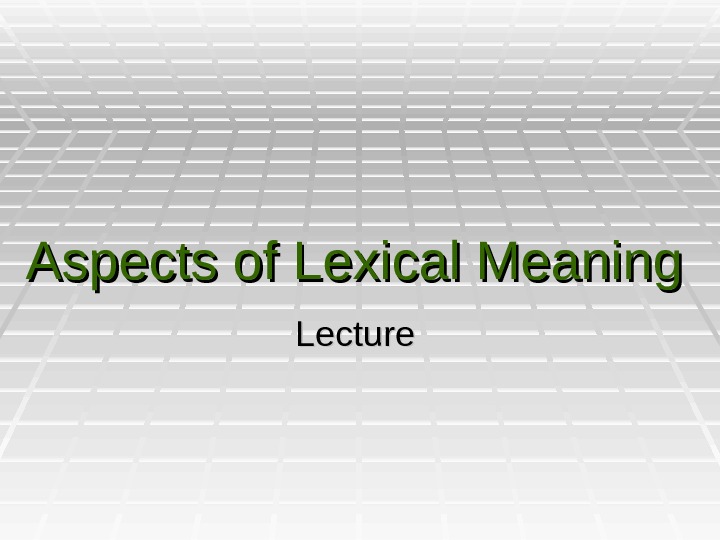

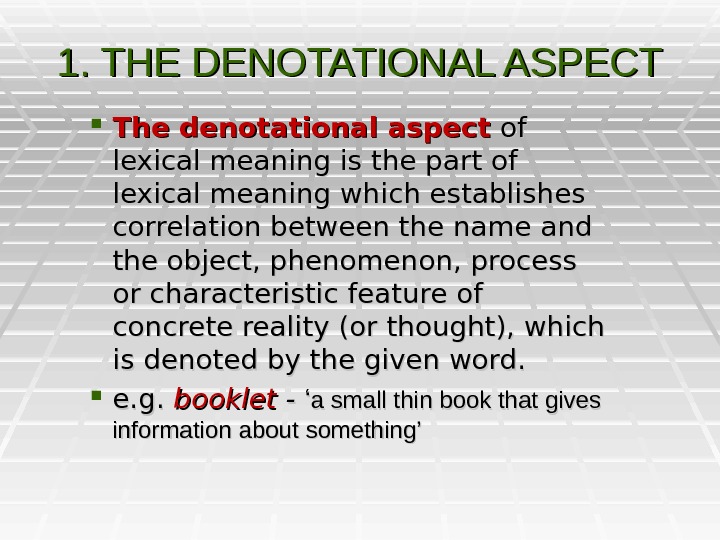
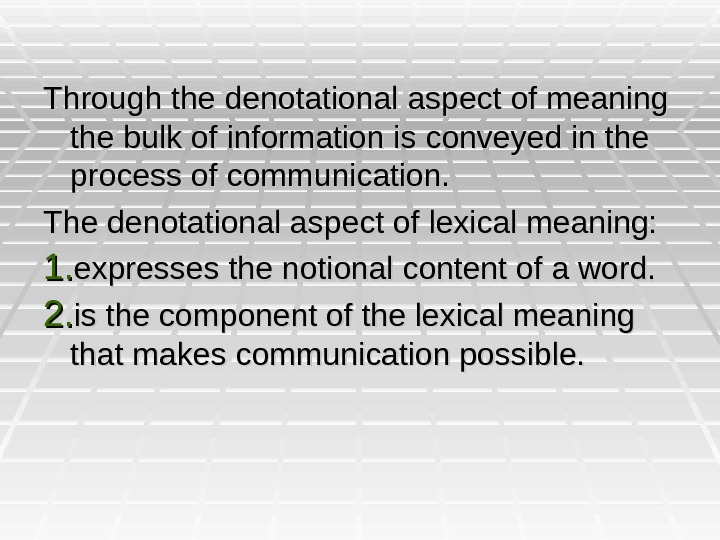


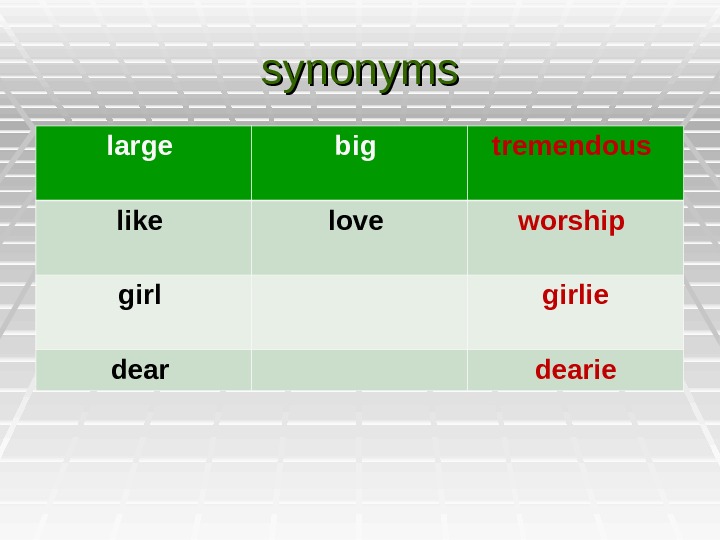
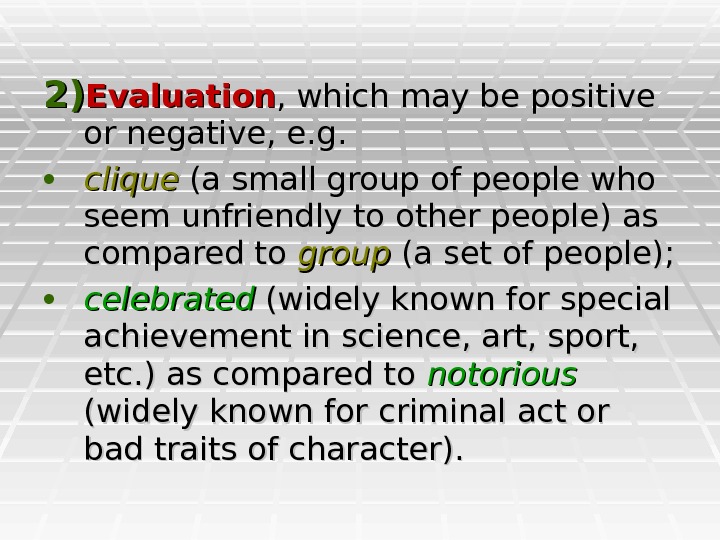
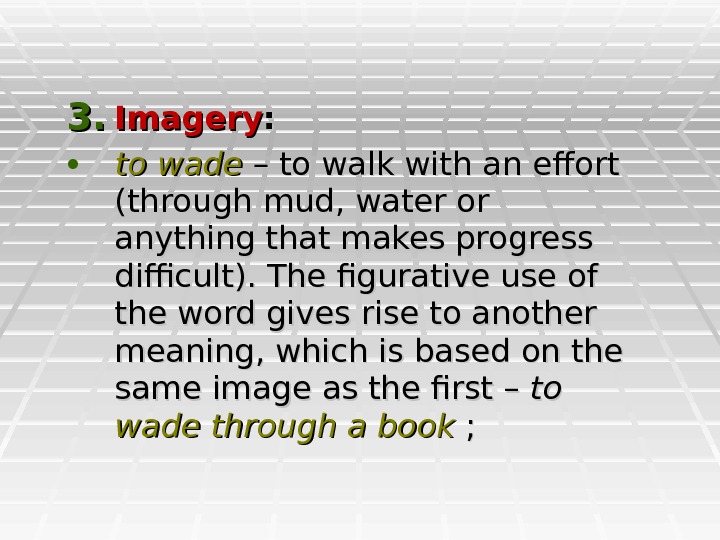
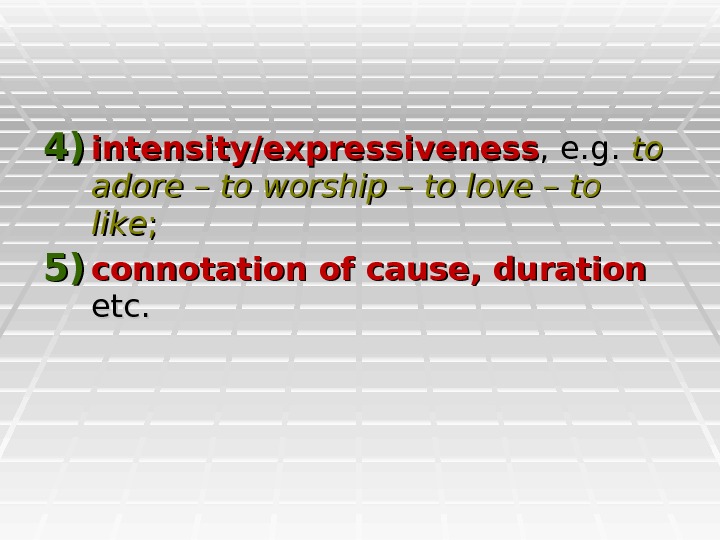



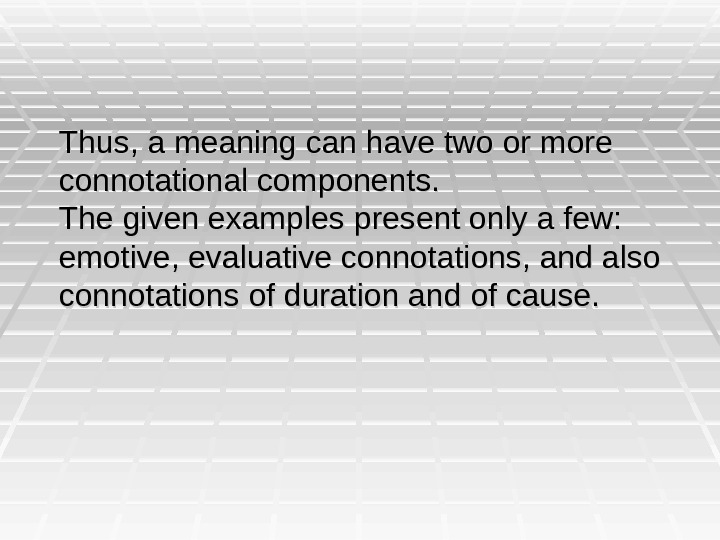




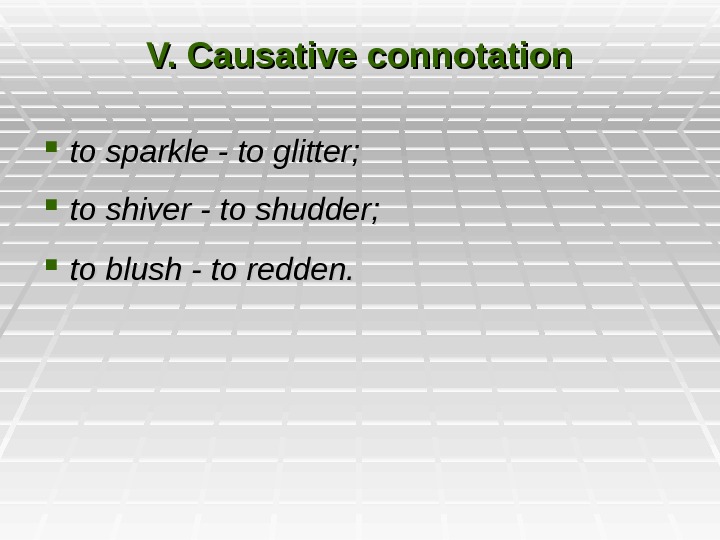
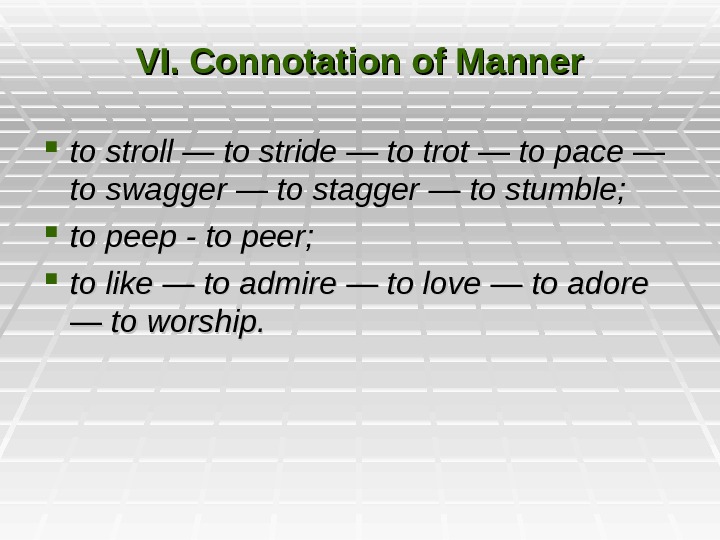
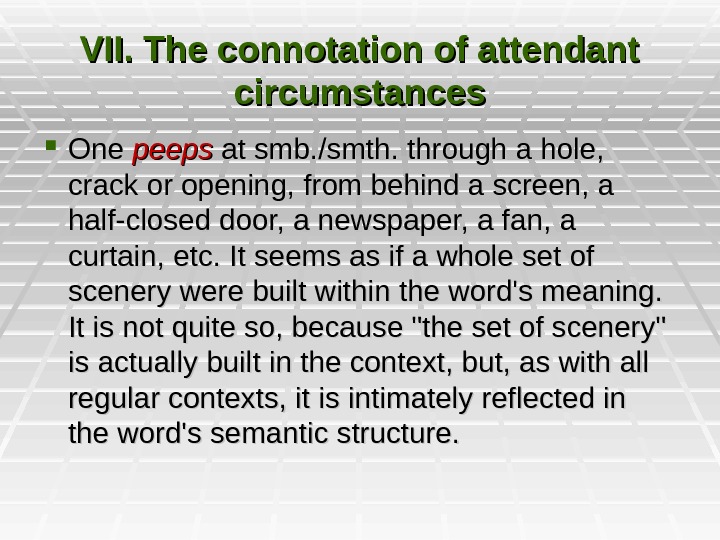
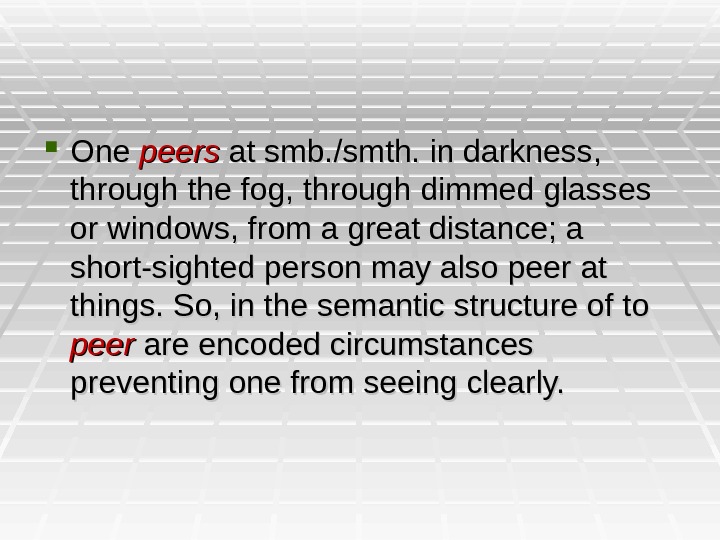

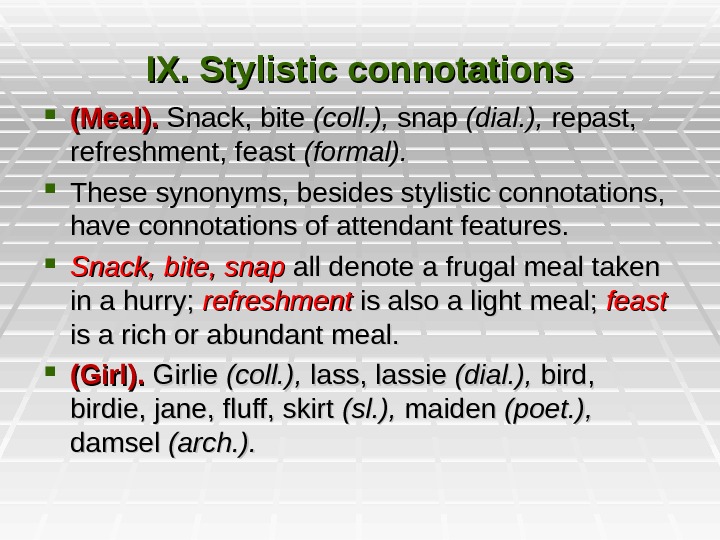




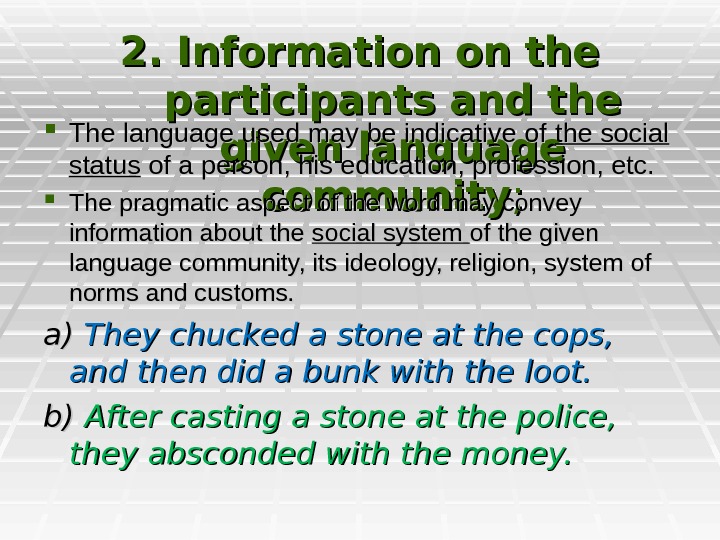

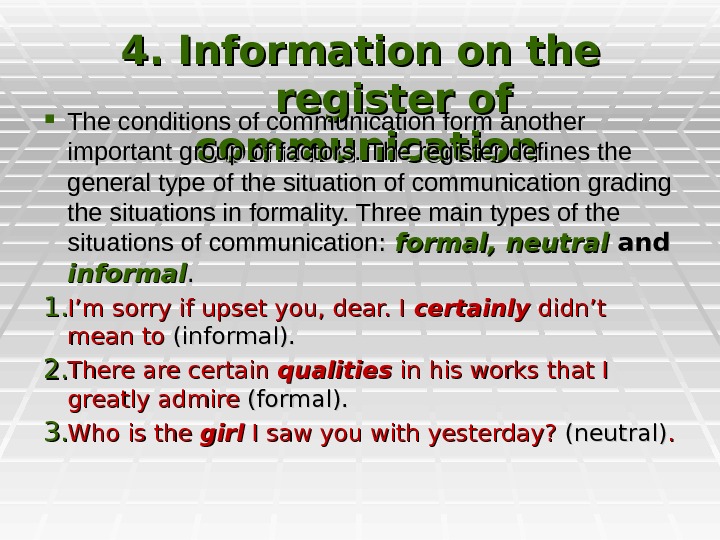
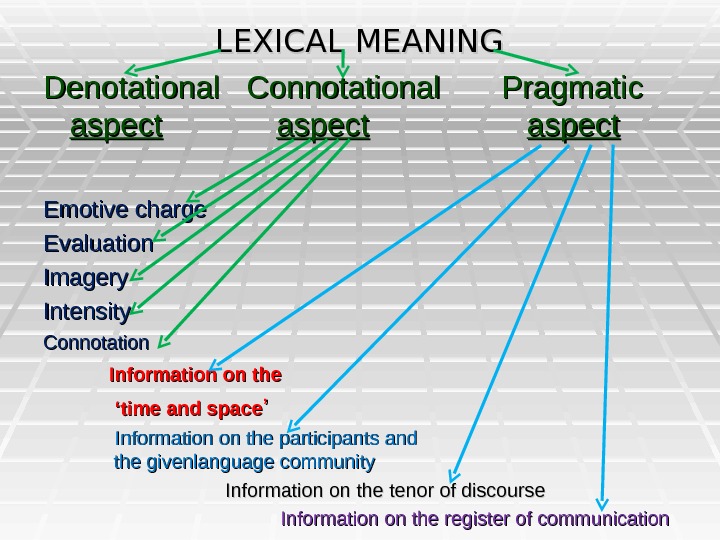
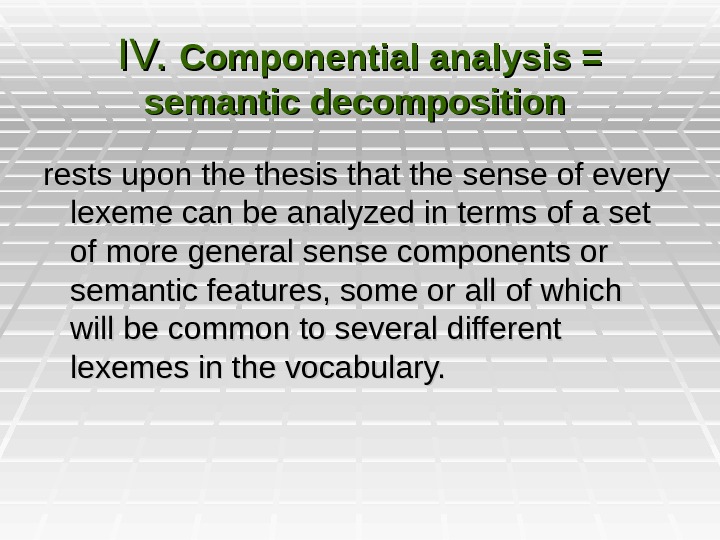
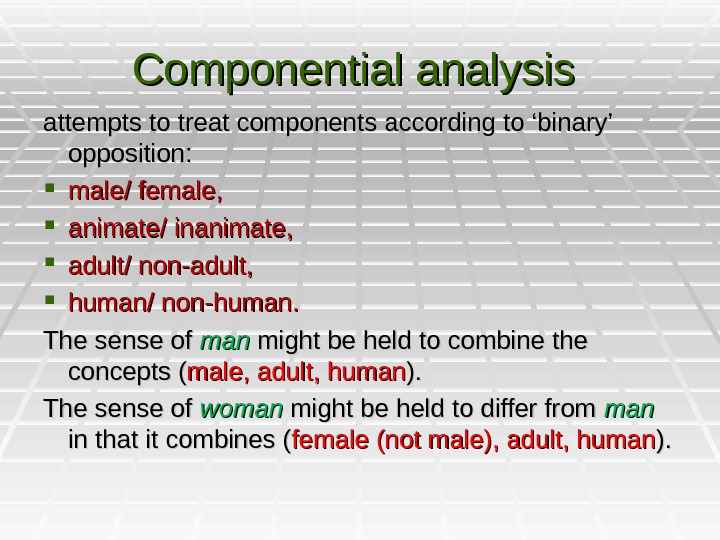
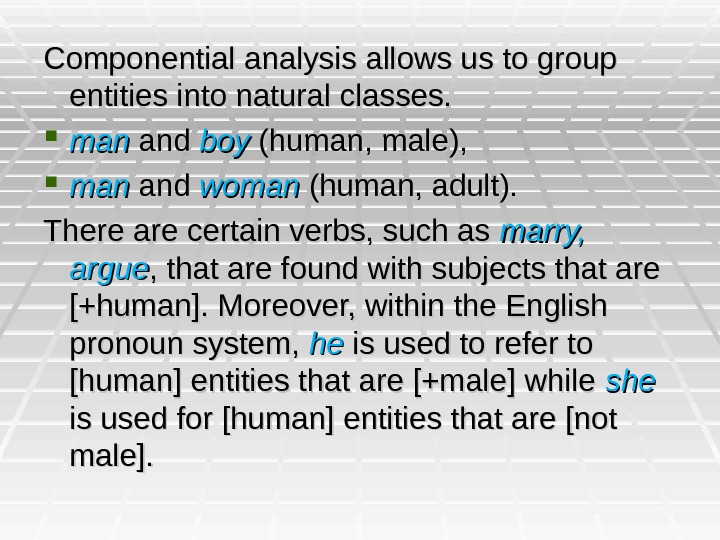

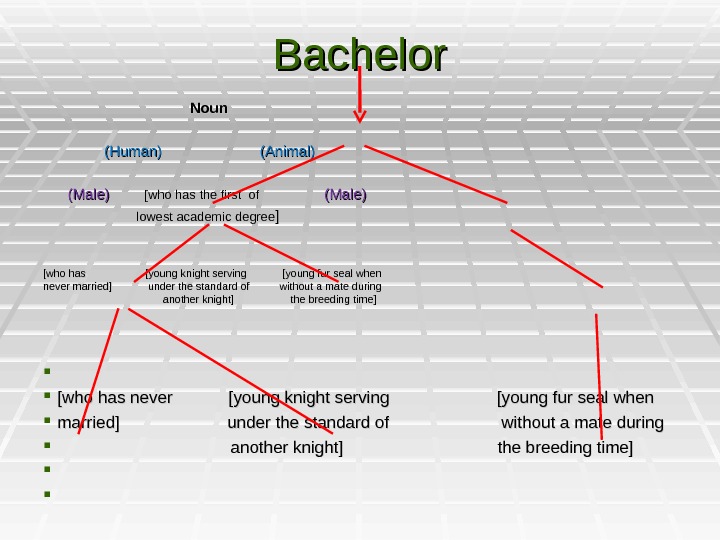
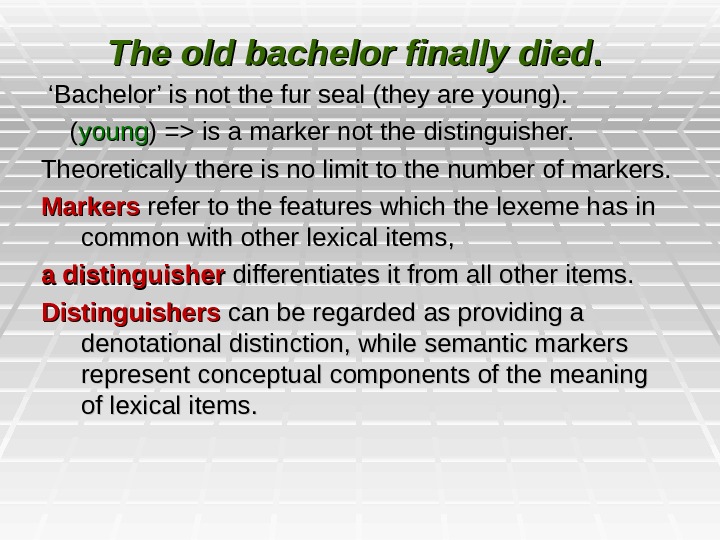
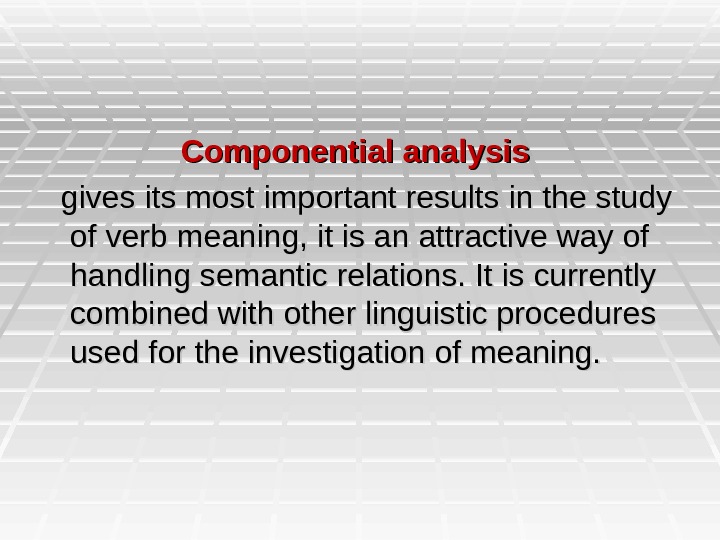
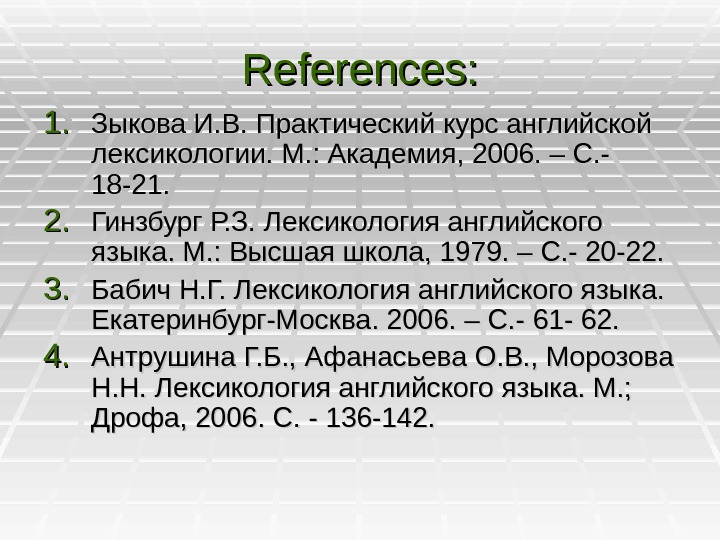
Слайд 1Aspects of Lexical Meaning
Lecture
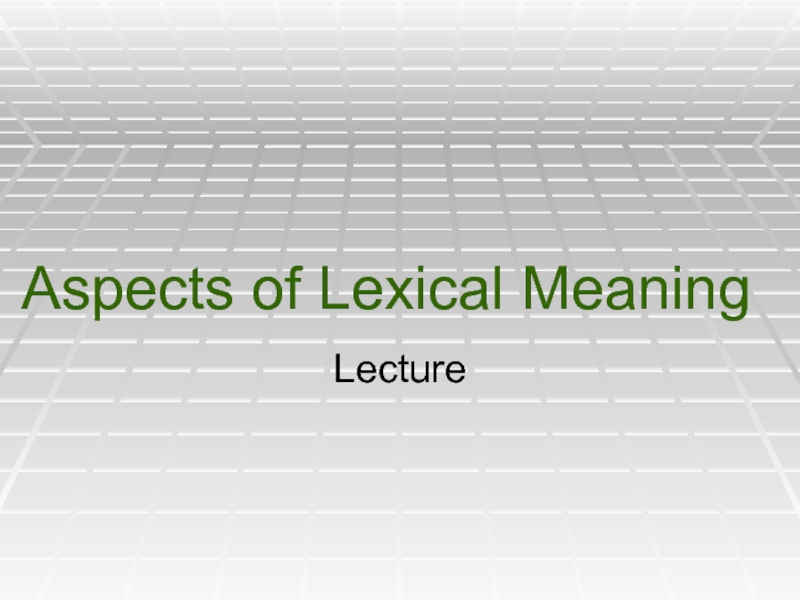
Слайд 2ASPECTS OF LEXICAL MEANING
THE DENOTATIONAL ASPECT
THE CONNOTATIONAL ASPECT
THE PRAGMATIC ASPECT
COMPONENTIAL ANALYSIS
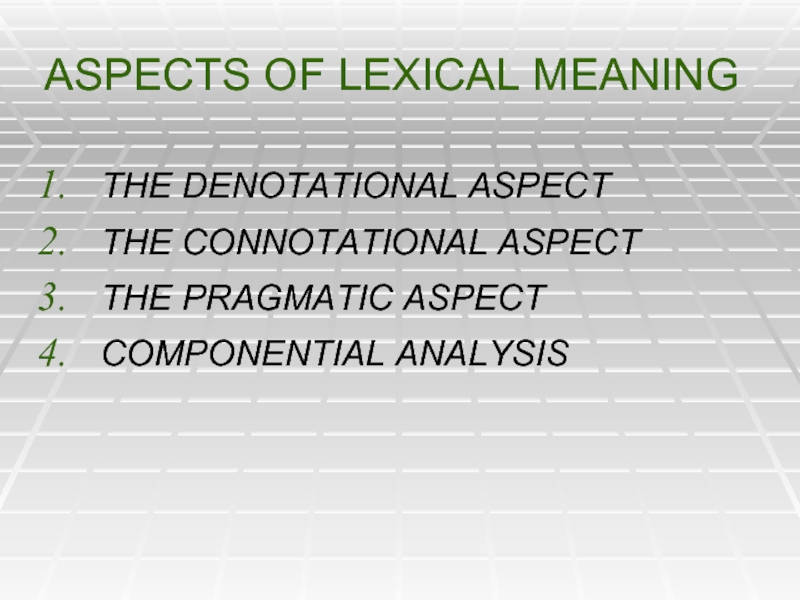
Слайд 31. THE DENOTATIONAL ASPECT
The denotational aspect of lexical meaning is the
part of lexical meaning which establishes correlation between the name and the object, phenomenon, process or characteristic feature of concrete reality (or thought), which is denoted by the given word.
e.g. booklet — ‘a small thin book that gives information about something’
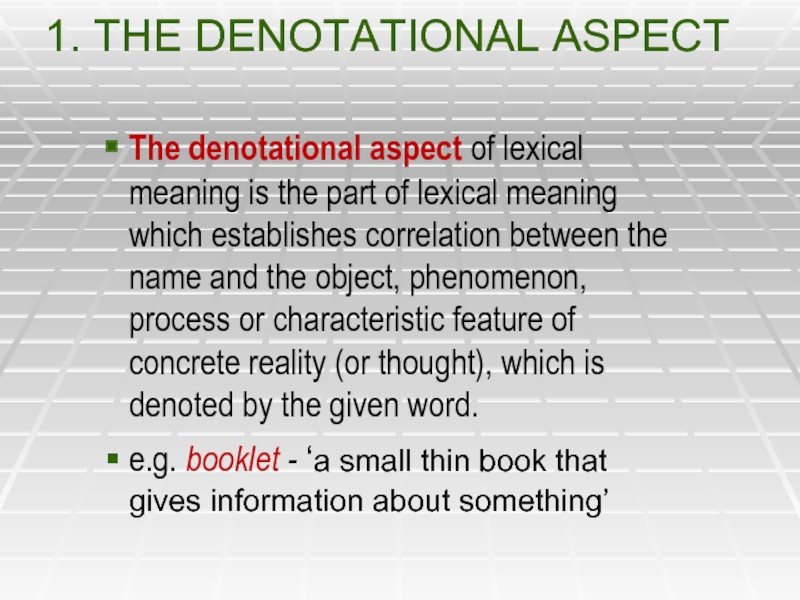
Слайд 4Through the denotational aspect of meaning the bulk of information is
conveyed in the process of communication.
The denotational aspect of lexical meaning:
expresses the notional content of a word.
is the component of the lexical meaning that makes communication possible.
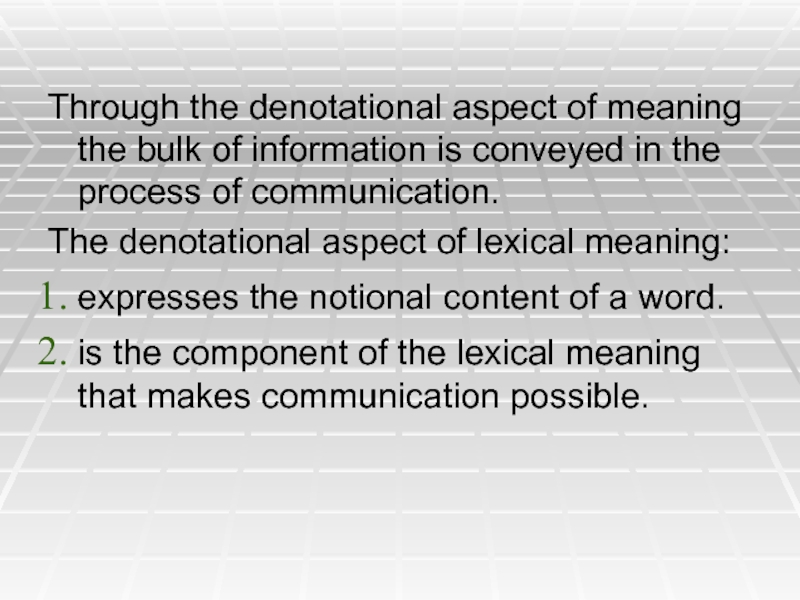
Слайд 52. THE CONNOTATIONAL ASPECT
The connotational aspect of lexical meaning is the
part of meaning which reflects the attitude of the speaker towards what he speaks about. Connotation conveys additional information in the process of communication.
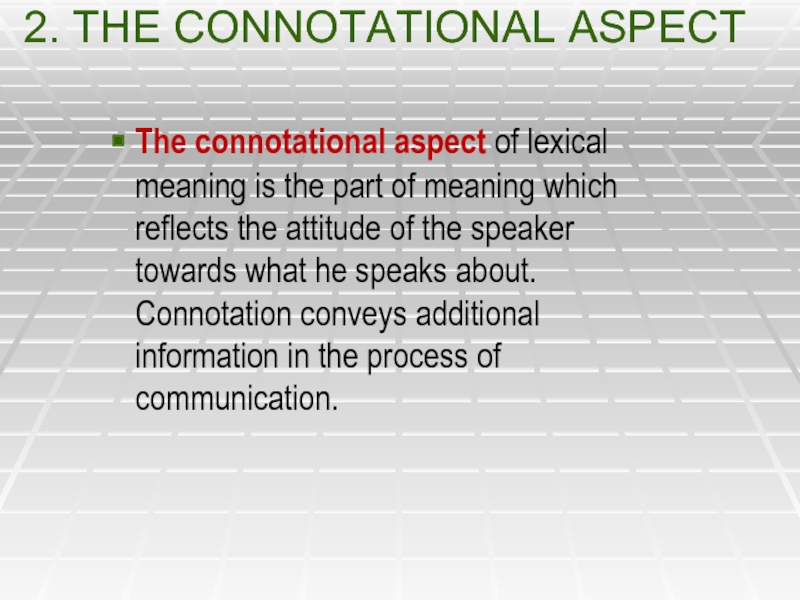
Слайд 6Connotation includes:
The emotive charge is one of the objective semantic features
proper to words as linguistic units and forms part of the connotational component of meaning, e.g. daddy as compared to father.
a hovel – ‘a small house or cottage’ – implies a miserable dwelling place, dirty, in bad repair and in general unpleasant to live in.
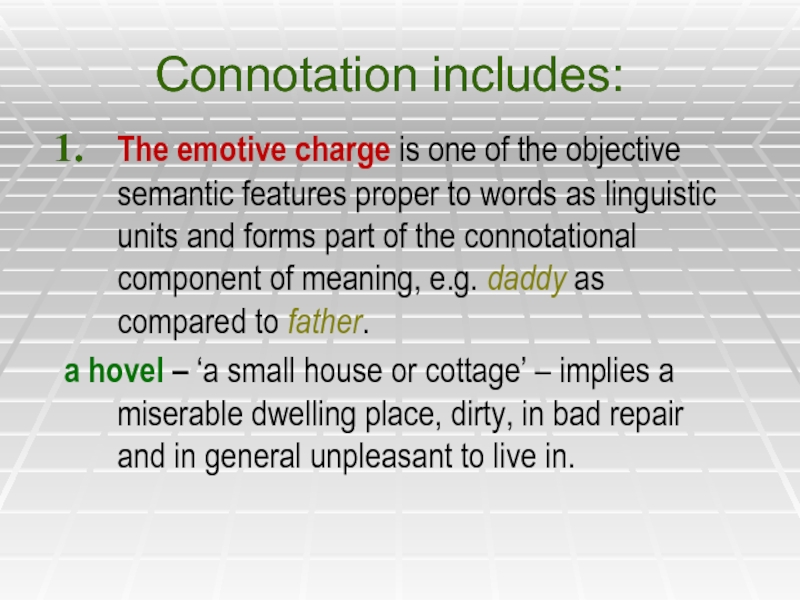
Слайд 8Evaluation, which may be positive or negative, e.g.
clique (a small
group of people who seem unfriendly to other people) as compared to group (a set of people);
celebrated (widely known for special achievement in science, art, sport, etc.) as compared to notorious (widely known for criminal act or bad traits of character).
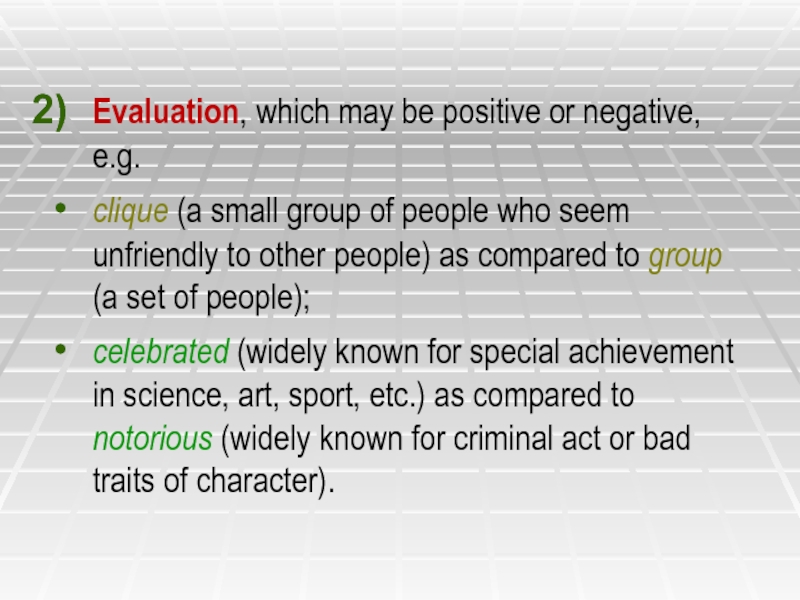
Слайд 9Imagery:
to wade – to walk with an effort (through mud,
water or anything that makes progress difficult). The figurative use of the word gives rise to another meaning, which is based on the same image as the first – to wade through a book ;
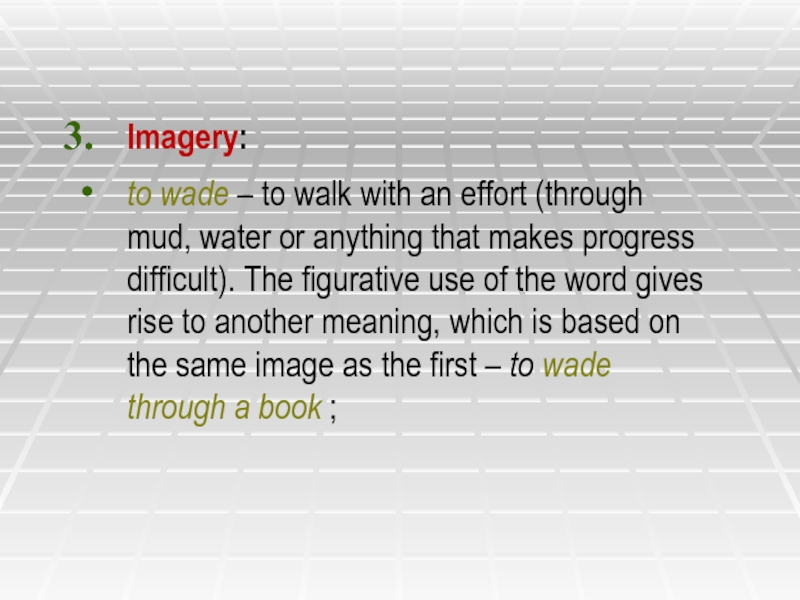
Слайд 10intensity/expressiveness, e.g. to adore – to worship – to love –
to like;
connotation of cause, duration etc.
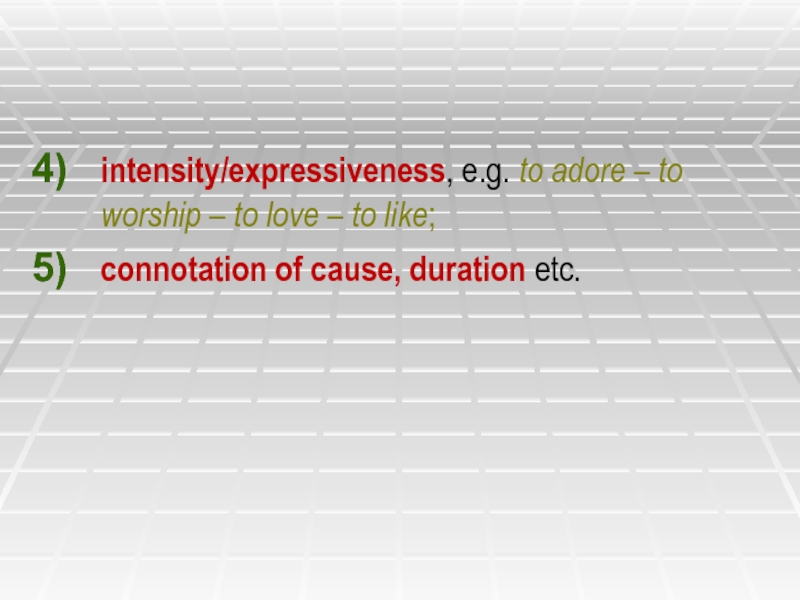
Слайд 14Thus, a meaning can have two or more connotational components.
The given
examples present only a few: emotive, evaluative connotations, and also connotations of duration and of cause.
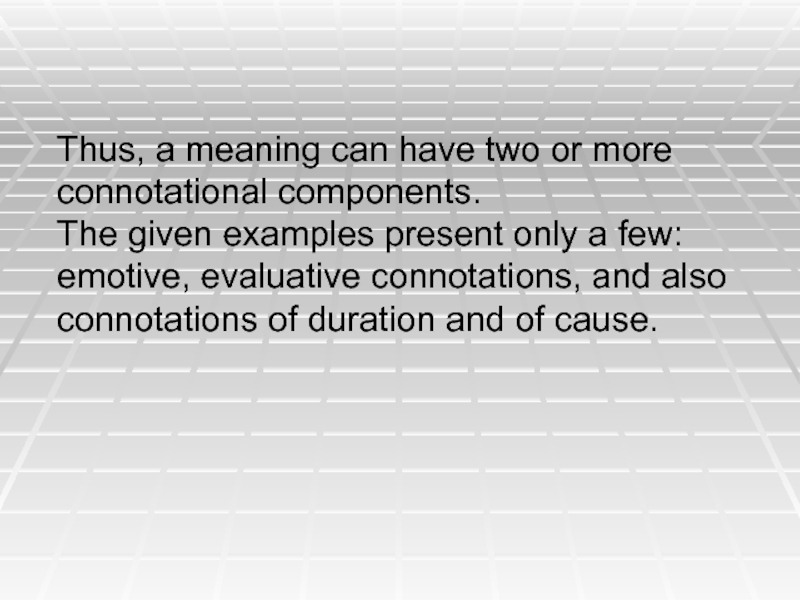
Слайд 153. Examples of different types of Connotation
I. The connotation of degree
or intensity
to surprise — to astonish — to amaze — to astound;
to satisfy — to please — to content — to gratify — to delight — to exalt;
to shout — to yell — to bellow — to roar; to like — to admire — to love — to adore — to worship
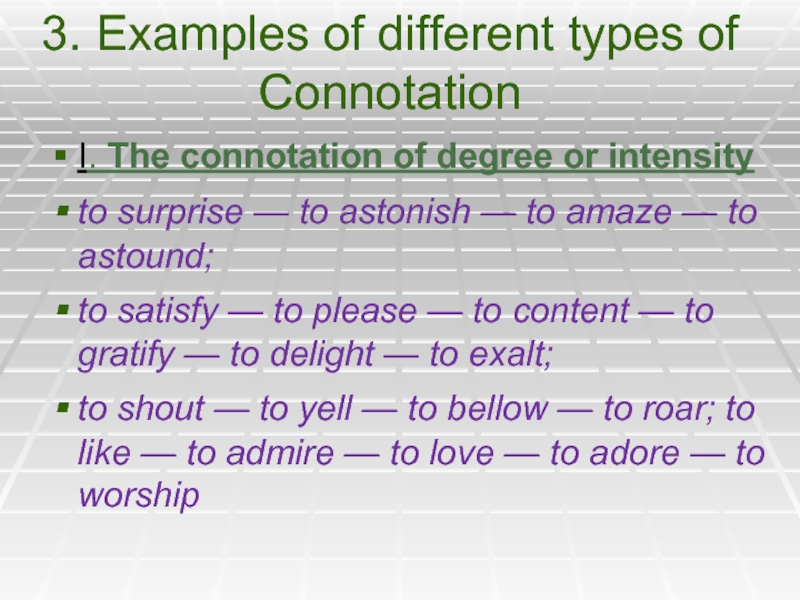
Слайд 16II. Connotation of duration
to stare — to glare — to gaze
— to glance — to peep — to peer;
to flash (brief) — to blaze (lasting);
to shudder (brief) — to shiver (lasting);
to say (brief) — to speak, to talk (lasting).
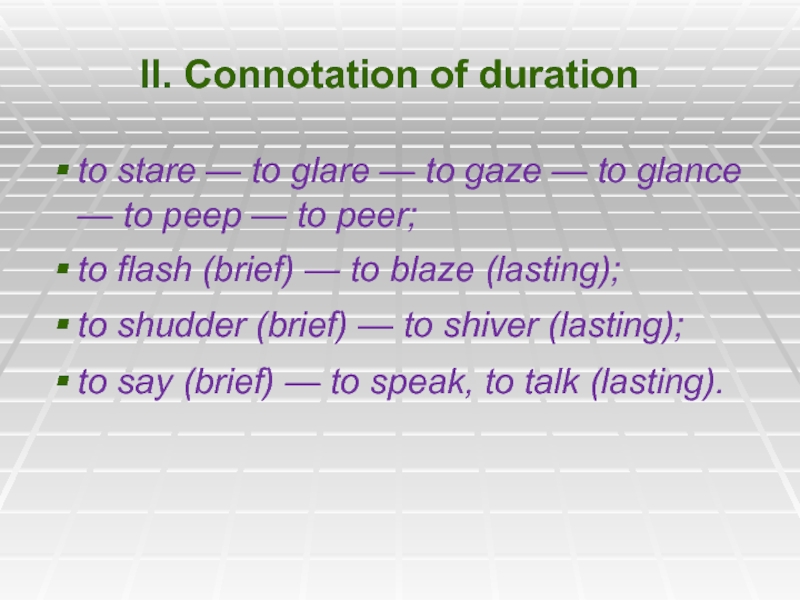
Слайд 17III. Emotive connotations
to stare — to glare — to gaze;
alone —
single — lonely — solitary;
to tremble — to shiver — to shudder — to shake;
to love — to admire — to adore — to worship;
angry — furious — enraged;
fear — terror — horror.
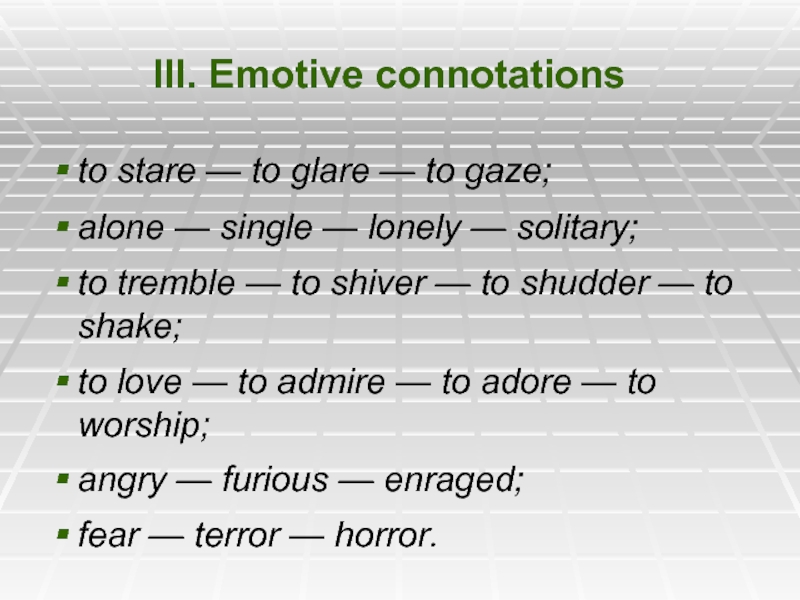
Слайд 18IV. The evaluative connotation
well-known — famous — notorious — celebrated;
to produce
— to create — to manufacture — to fabricate;
to sparkle — to glitter;
A. His (her) eyes sparkled with amusement, merriment, good humour, high spirits, happiness, etc. (positive emotions).
B. His (her) eyes glittered with anger, rage, hatred,
malice, etc. (negative emotions).
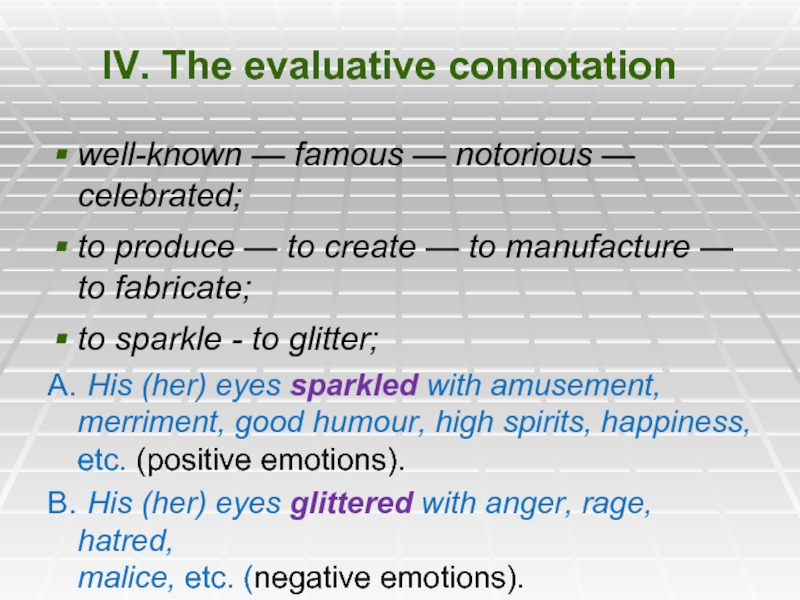
Слайд 19V. Causative connotation
to sparkle — to glitter;
to shiver — to shudder;
to
blush — to redden.
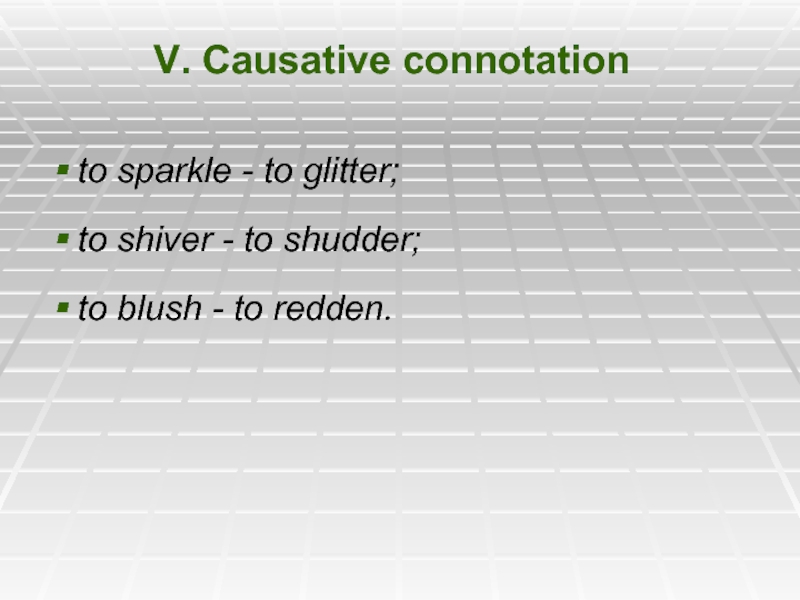
Слайд 20VI. Connotation of Manner
to stroll — to stride — to trot
— to pace — to swagger — to stagger — to stumble;
to peep — to peer;
to like — to admire — to love — to adore — to worship.
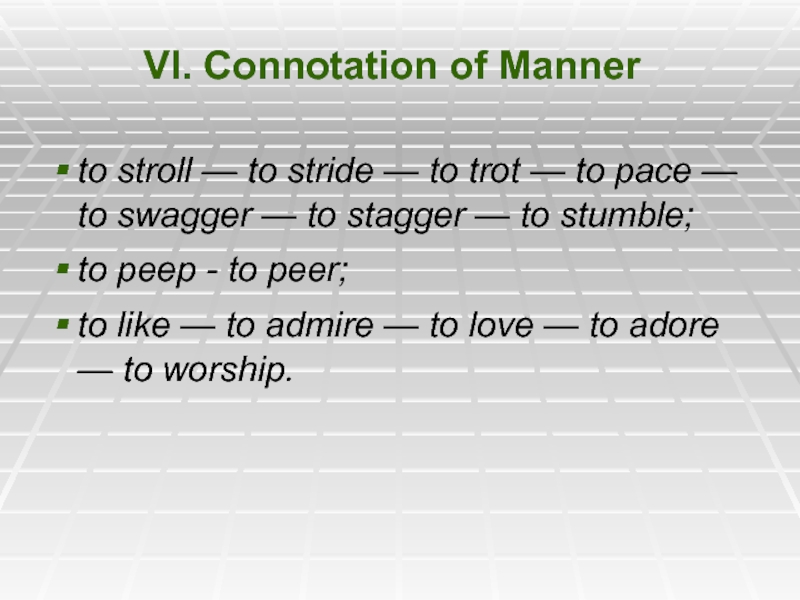
Слайд 21VII. The connotation of attendant circumstances
One peeps at smb./smth. through a
hole, crack or opening, from behind a screen, a half-closed door, a newspaper, a fan, a curtain, etc. It seems as if a whole set of scenery were built within the word’s meaning. It is not quite so, because «the set of scenery» is actually built in the context, but, as with all regular contexts, it is intimately reflected in the word’s semantic structure.
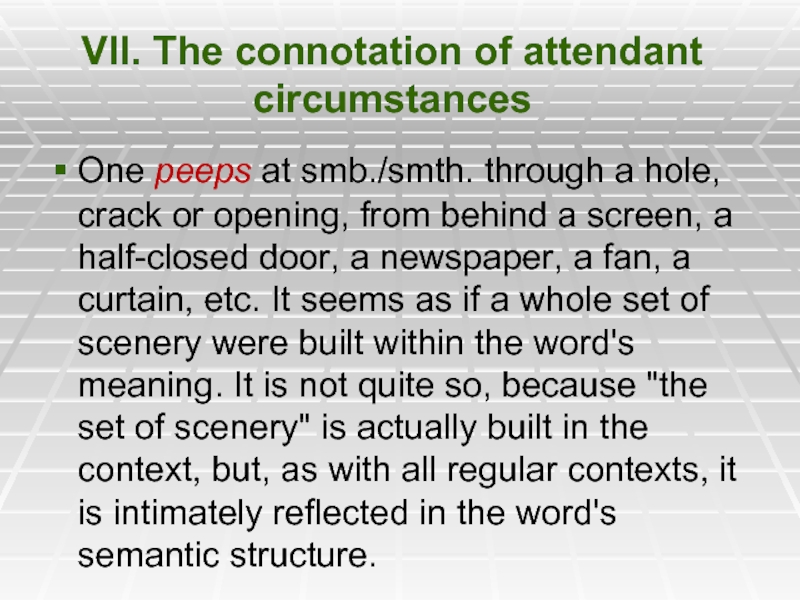
Слайд 22One peers at smb./smth. in darkness, through the fog, through dimmed
glasses or windows, from a great distance; a short-sighted person may also peer at things. So, in the semantic structure of to peer are encoded circumstances preventing one from seeing clearly.
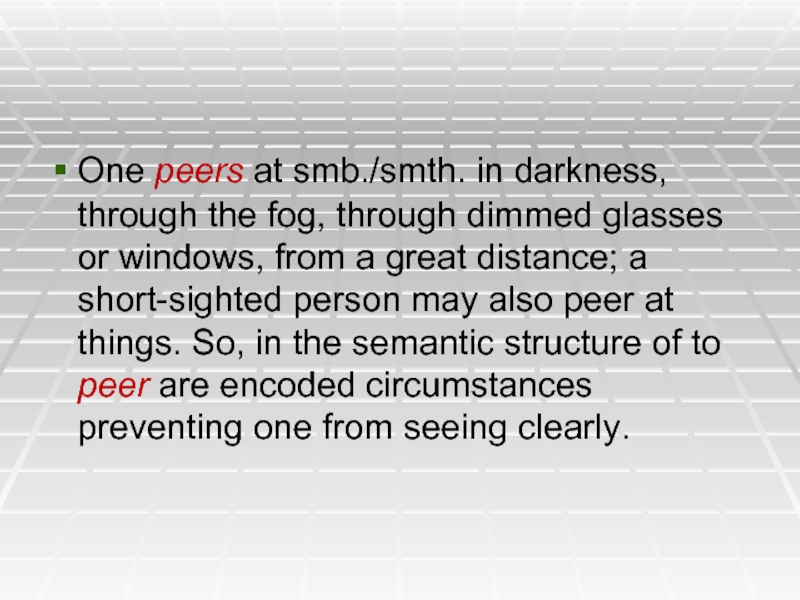
Слайд 23VII. Connotation of attendant features
Pretty – handsome – beautiful;
special types
of human beauty:
beautiful is mostly associated with classical features and a perfect figure;
handsome with a tall stature, a certain robustness and fine proportions,
pretty with small delicate features and a fresh complexion.
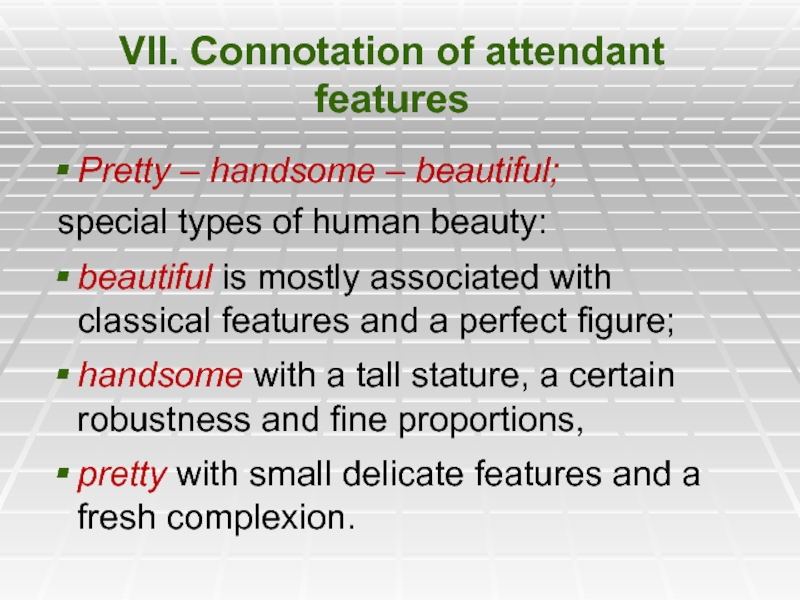
Слайд 24IX. Stylistic connotations
(Meal). Snack, bite (coll.), snap (dial.), repast, refreshment, feast
(formal).
These synonyms, besides stylistic connotations, have connotations of attendant features.
Snack, bite, snap all denote a frugal meal taken in a hurry; refreshment is also a light meal; feast is a rich or abundant meal.
(Girl). Girlie (coll.), lass, lassie (dial.), bird, birdie, jane, fluff, skirt (sl.), maiden (poet.), damsel (arch.).
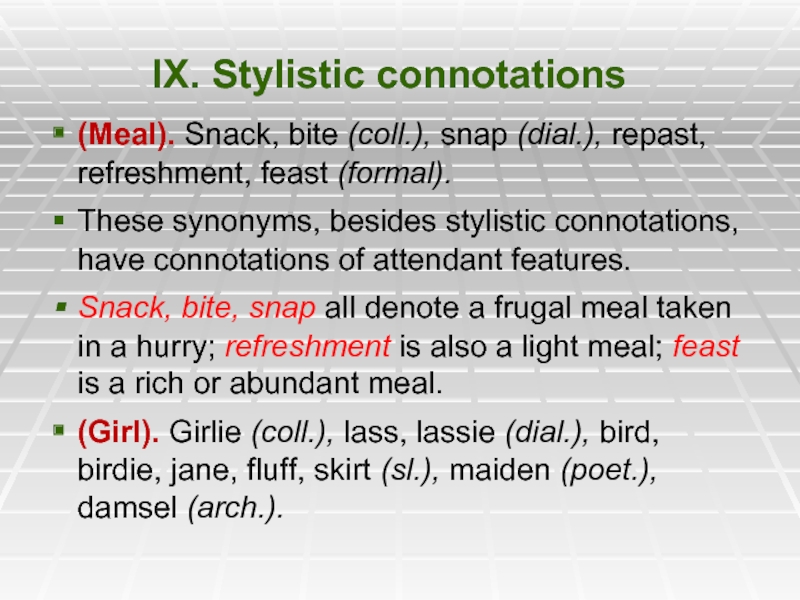
Слайд 25Anecdote
J a n e: Would you be insulted if that
good-looking stranger offered you some champagne?
J o a n: Yes, but I’d probably swallow the insult.
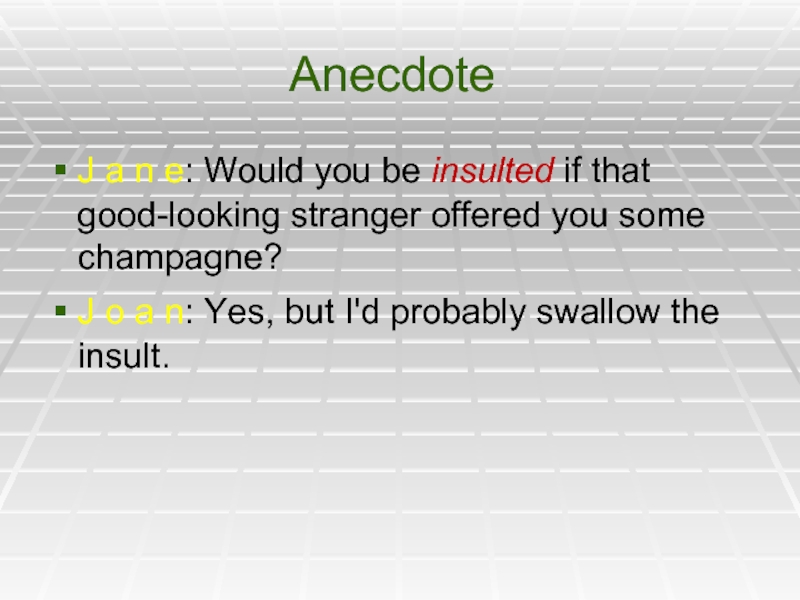
Слайд 263. THE PRAGMATIC ASPECT
The pragmatic aspect is the part of lexical
meaning that conveys information on the situation of communication. Like the connotational aspect, the pragmatic aspect falls into four closely linked together subsections.
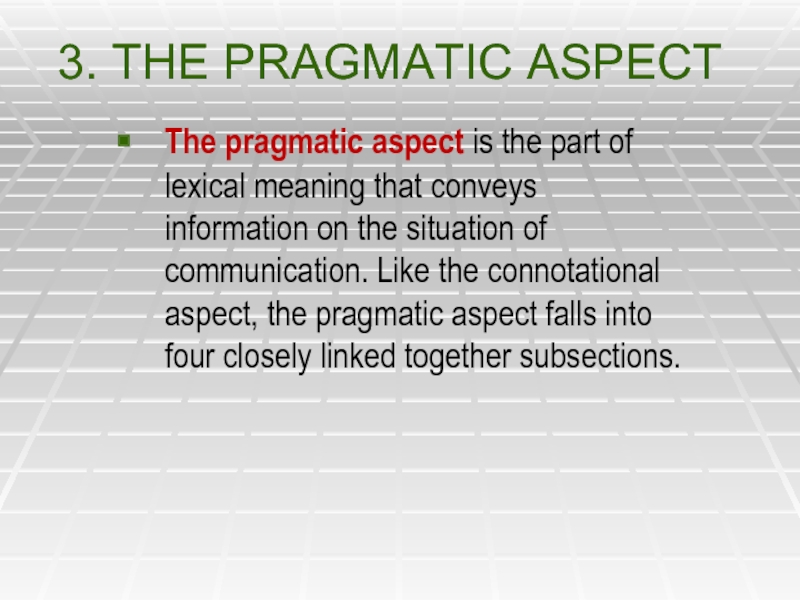
Слайд 27
1. Information on the ‘time and space’ relationship of the participants
Some
information which specifies different parameters of communication may be conveyed not only with the help of grammatical means (tense forms, personal pronouns, etc), but through the meaning of the word.
E.g. come and go can indicate the location of the speaker who is usually taken as the zero point in the description of the situation of communication
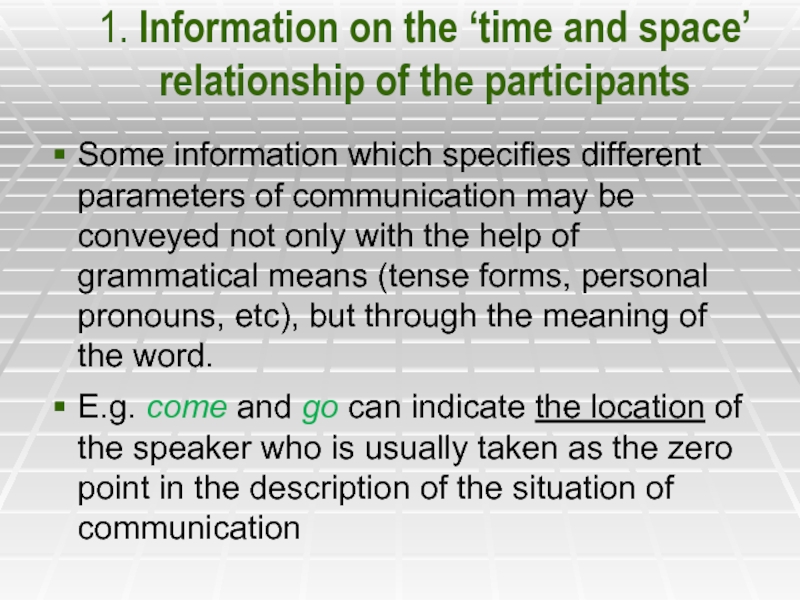
Слайд 28The time element is fixed indirectly. Indirect reference to time implies
that the frequency of occurrence of words may change with time and in extreme cases words may be out of use or become obsolete.
E.g.the word behold – ‘take notice, see (smth unusual)’ as well as the noun beholder – ‘spectator’ are out of use now but were widely used in the 17th century.
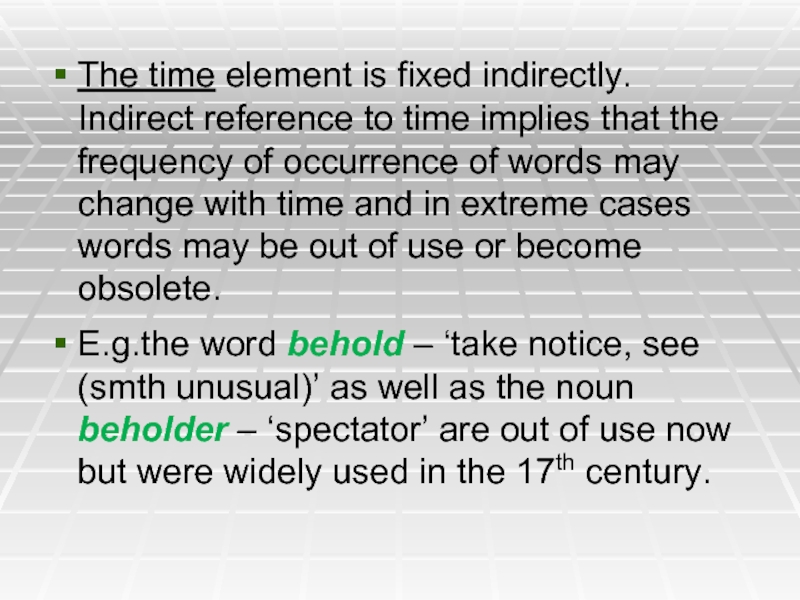
Слайд 292. Information on the participants and the given language community;
The language
used may be indicative of the social status of a person, his education, profession, etc.
The pragmatic aspect of the word may convey information about the social system of the given language community, its ideology, religion, system of norms and customs.
a) They chucked a stone at the cops, and then did a bunk with the loot.
b) After casting a stone at the police, they absconded with the money.
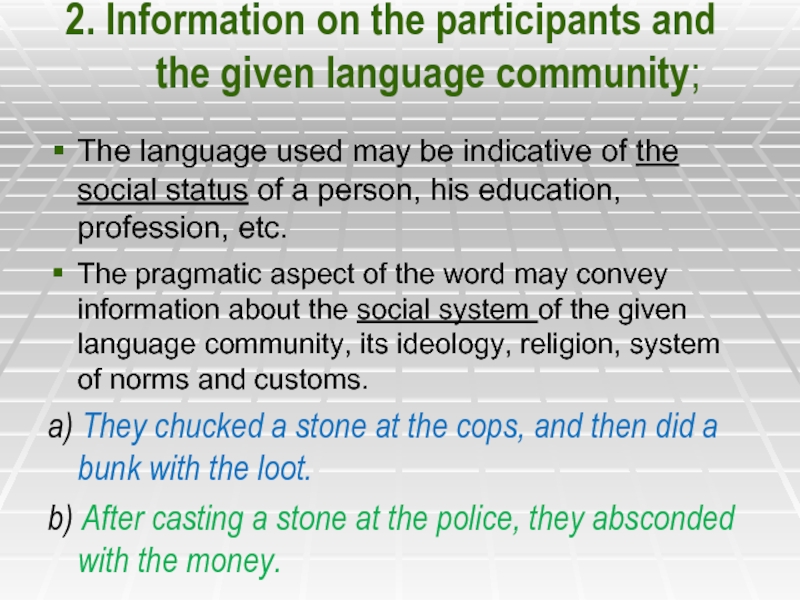
Слайд 303. Information on the tenor of discourse
The tenors of discourse reflect
how the addresser (the speaker or the writer) interacts with the addressee (the listener or reader).
Tenors are based on social or family roles of the participants of communication.
1. Don’t interrupt when your mother is speaking (family roles).
2. There is an awful man in the front row, who butts in whenever you pause (social roles).
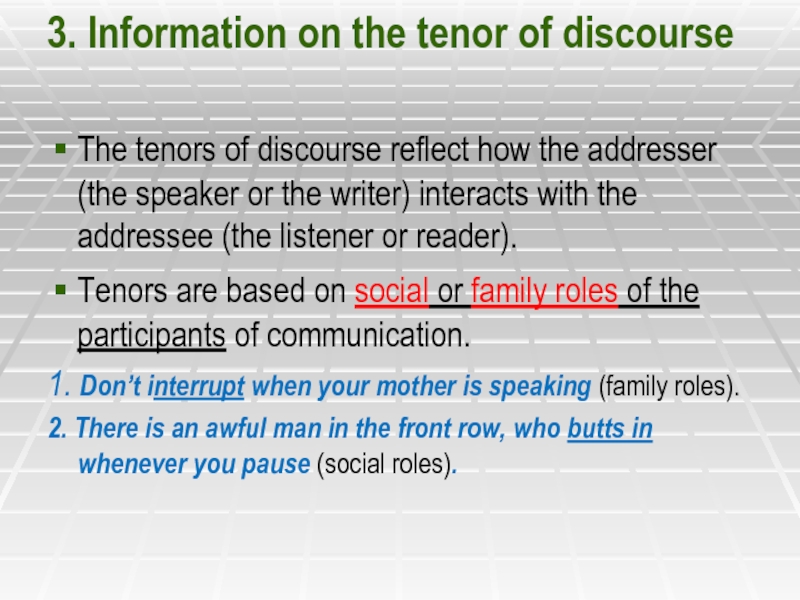
Слайд 314. Information on the register of communication
The conditions of
communication form another important group of factors. The register defines the general type of the situation of communication grading the situations in formality. Three main types of the situations of communication: formal, neutral and informal.
I’m sorry if upset you, dear. I certainly didn’t mean to (informal).
There are certain qualities in his works that I greatly admire (formal).
Who is the girl I saw you with yesterday? (neutral).

Слайд 32LEXICAL MEANING
Denotational Connotational Pragmatic aspect
aspect aspect
Emotive charge
Evaluation
Imagery
Intensity
Connotation
Information on the
‘time and space’
Information on the participants and
the givenlanguage community
Information on the tenor of discourse
Information on the register of communication
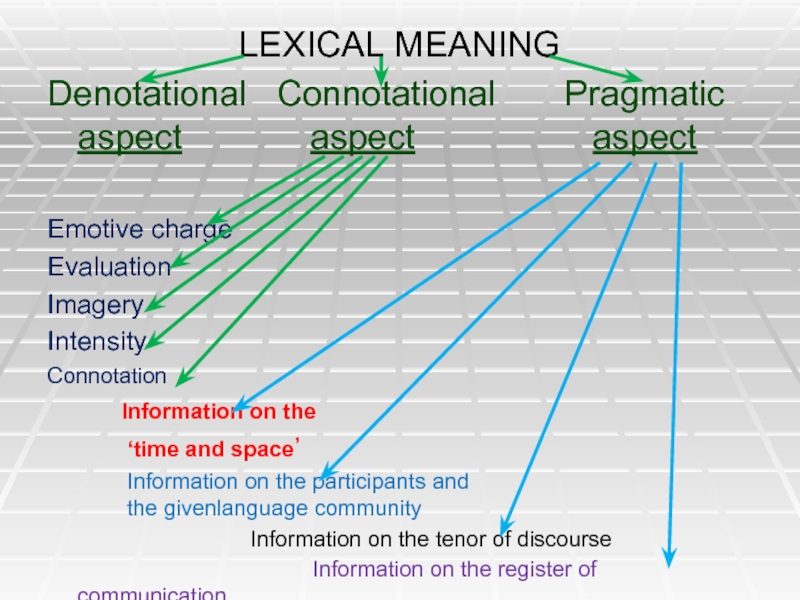
Слайд 33IV. Componential analysis = semantic decomposition
rests upon the thesis that
the sense of every lexeme can be analyzed in terms of a set of more general sense components or semantic features, some or all of which will be common to several different lexemes in the vocabulary.
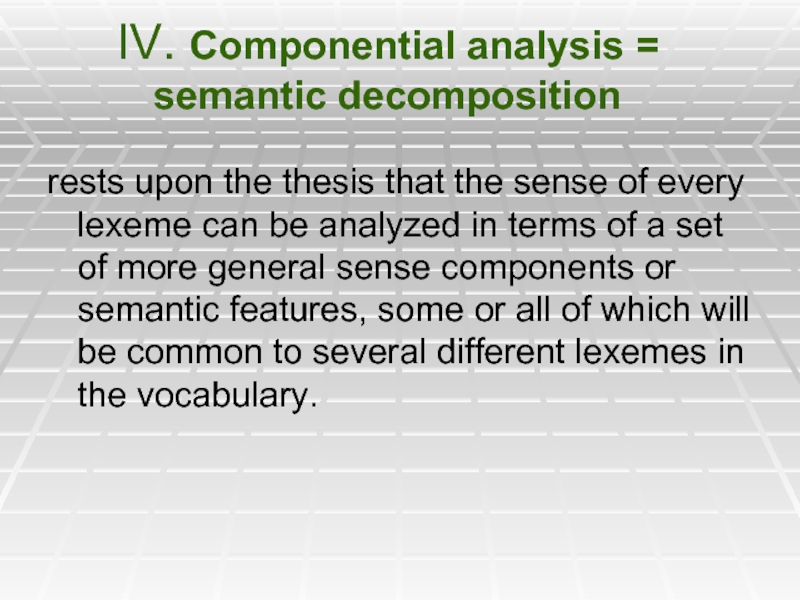
Слайд 34Componential analysis
attempts to treat components according to ‘binary’ opposition:
male/
female,
animate/ inanimate,
adult/ non-adult,
human/ non-human.
The sense of man might be held to combine the concepts (male, adult, human).
The sense of woman might be held to differ from man in that it combines (female (not male), adult, human).
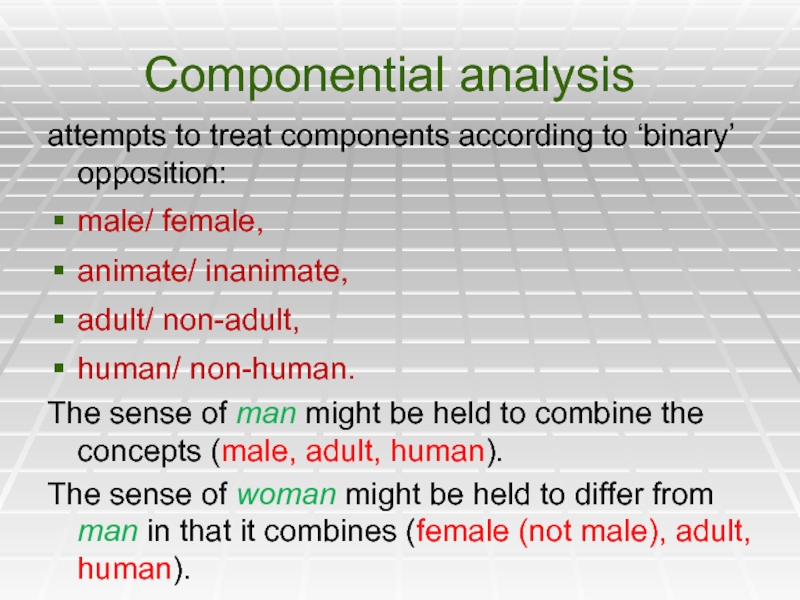
Слайд 35Componential analysis allows us to group entities into natural classes.
man
and boy (human, male),
man and woman (human, adult).
There are certain verbs, such as marry, argue, that are found with subjects that are [+human]. Moreover, within the English pronoun system, he is used to refer to [human] entities that are [+male] while she is used for [human] entities that are [not male].
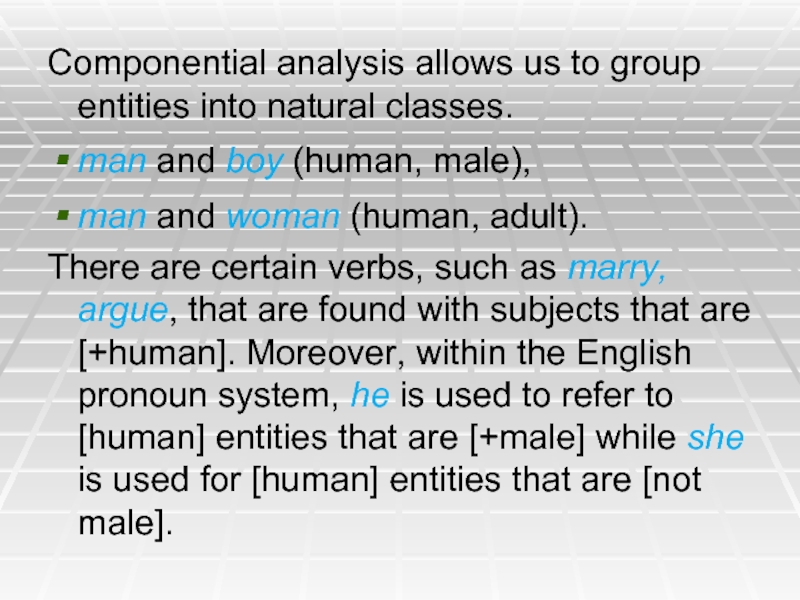
Слайд 36Componential analysis of the word ‘bachelor’
According to the dictionary it has
4 meanings:
a man who has never married (холостяк);
a young knight (рыцарь);
someone with a first degree (бакалавр);
a young male unmated fur seal (морской котик) during the mating season.
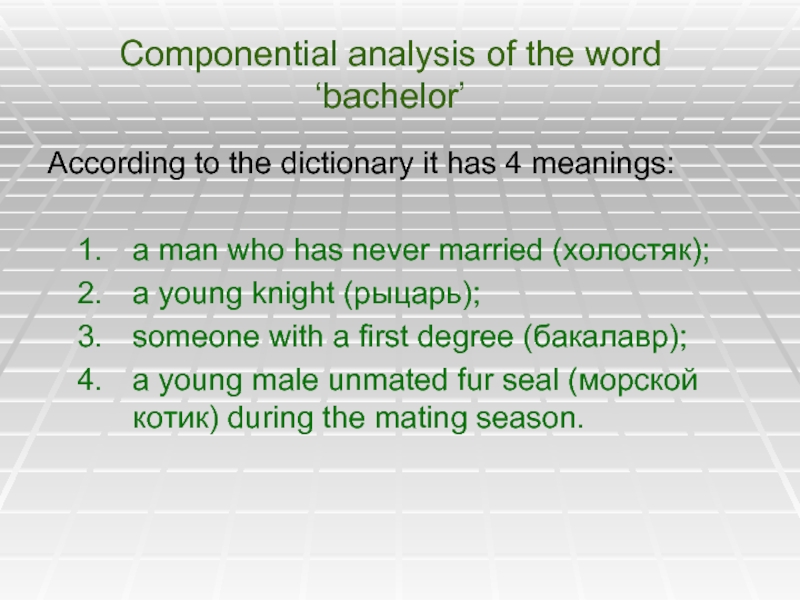
Слайд 37Bachelor
Noun
(Human) (Animal)
(Male) [who has the first of (Male)
lowest academic degree]
[who has [young knight serving [young fur seal when
never married] under the standard of without a mate during
another knight] the breeding time]
[who has never [young knight serving [young fur seal when
married] under the standard of without a mate during
another knight] the breeding time]
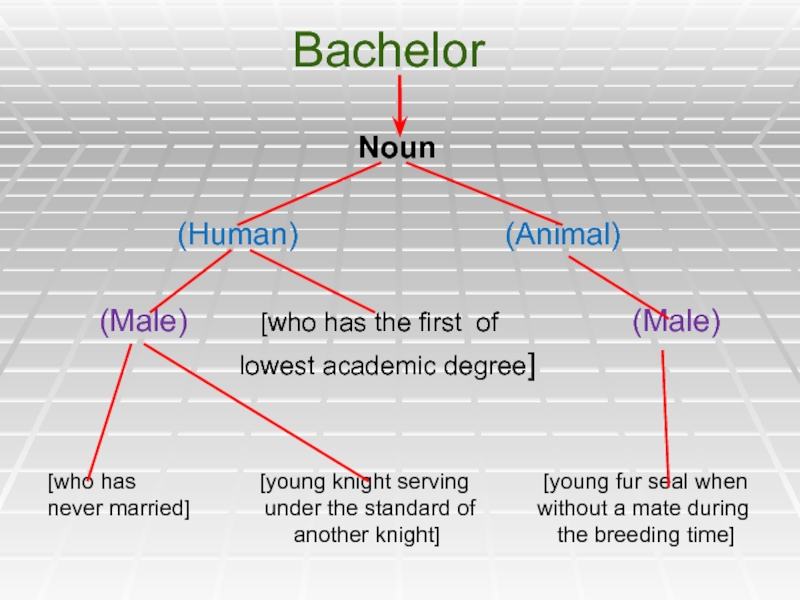
Слайд 38The old bachelor finally died.
‘Bachelor’ is not the fur
seal (they are young).
(young) => is a marker not the distinguisher.
Theoretically there is no limit to the number of markers.
Markers refer to the features which the lexeme has in common with other lexical items,
a distinguisher differentiates it from all other items.
Distinguishers can be regarded as providing a denotational distinction, while semantic markers represent conceptual components of the meaning of lexical items.
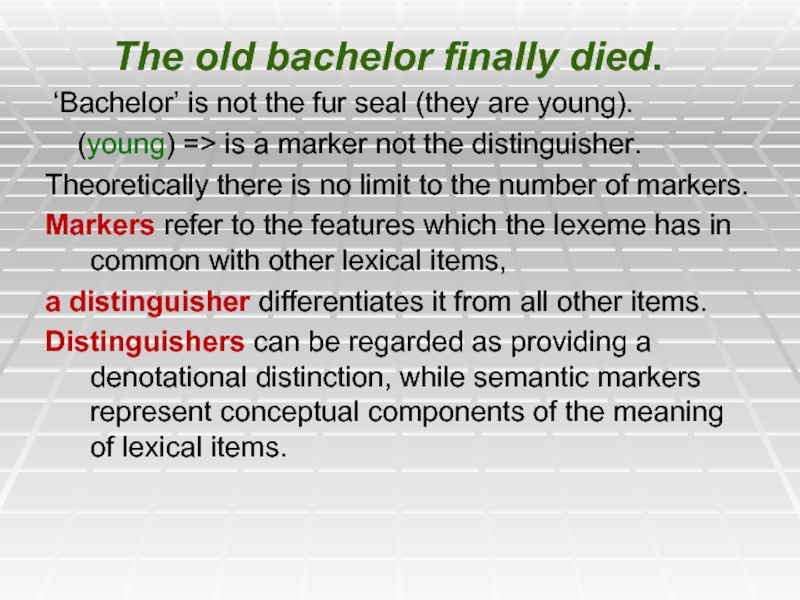
Слайд 39Componential analysis
gives its most important results in the study
of verb meaning, it is an attractive way of handling semantic relations. It is currently combined with other linguistic procedures used for the investigation of meaning.
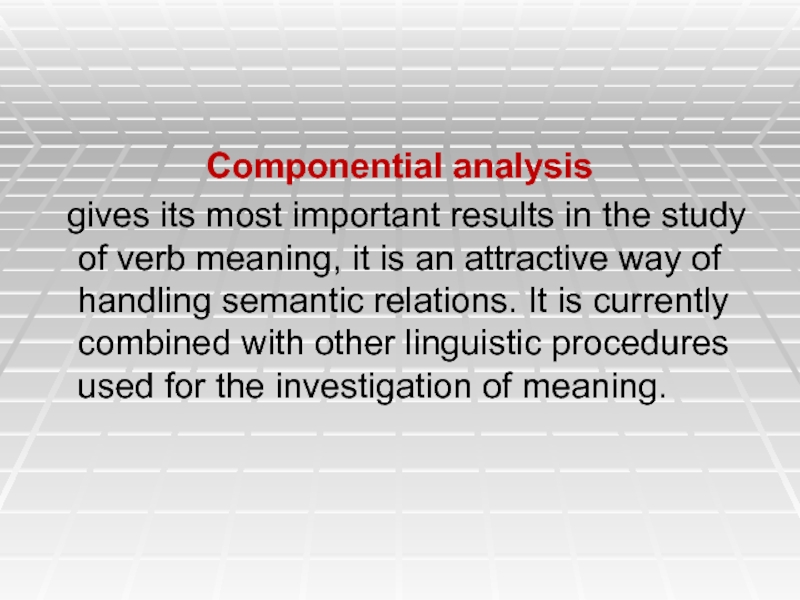
Слайд 40References:
Зыкова И.В. Практический курс английской лексикологии. М.: Академия, 2006. – С.-
18-21.
Гинзбург Р.З. Лексикология английского языка. М.: Высшая школа, 1979. – С.- 20-22.
Бабич Н.Г. Лексикология английского языка. Екатеринбург-Москва. 2006. – С.- 61- 62.
Антрушина Г.Б., Афанасьева О.В., Морозова Н.Н. Лексикология английского языка. М.; Дрофа, 2006. С. — 136-142.








































